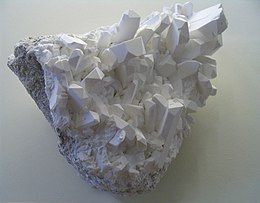Our website is made possible by displaying online advertisements to our visitors.
Please consider supporting us by disabling your ad blocker.
Borax

| |

| |
| Names | |
|---|---|
| IUPAC name
disodium;3,7-dioxido-2,4,6,8,9-pentaoxa-1,3,5,7-tetraborabicyclo[3.3.1]nonane;decahydrate[1]
| |
Other names
| |
| Identifiers | |
3D model (JSmol)
|
|
| ChEBI | |
| ChEMBL | |
| ChemSpider | |
| EC Number | |
| E number | E285 (preservatives) |
| KEGG | |
PubChem CID
|
|
| RTECS number |
|
| UNII | |
CompTox Dashboard (EPA)
|
|
| |
| |
| Properties | |
| Na2B4O5(OH)4·8H2O | |
| Molar mass | 381.36 g·mol−1 |
| Appearance | White or colorless crystalline solid |
| Density | 1.73 g/cm3 (decahydrate, solid)[2] |
| Melting point | 743 °C (1,369 °F; 1,016 K) (anhydrous)[2] 75 °C (decahydrate, decomposes)[2] |
| Boiling point | 1,575 °C (2,867 °F; 1,848 K) (anhydrous)[2] |
| 31.7 g/L [2] | |
| −85.0·10−6 cm3/mol (anhydrous)[2]: p.4.135 | |
Refractive index (nD)
|
n1=1.447, n2=1.469, n3=1.472 (decahydrate)[2]: p.4.139 |
| Structure[3] | |
| Monoclinic, mS92, No. 15 | |
| C2/c | |
| 2/m | |
a = 1.1885 nm, b = 1.0654 nm, c = 1.2206 nm α = 90°, β = 106.623°°, γ = 90°
| |
Lattice volume (V)
|
1.4810 nm3 |
Formula units (Z)
|
4 |
| Pharmacology | |
| S01AX07 (WHO) | |
| Hazards | |
| GHS labelling: | |

| |
| H360 | |
| P201, P308+P313 | |
| NFPA 704 (fire diamond) | |
| NIOSH (US health exposure limits): | |
PEL (Permissible)
|
none[4] |
REL (Recommended)
|
TWA 1 mg/m3 (anhydrous and pentahydrate)[4][5] TWA 5 mg/m3 (decahydrate)[6] |
IDLH (Immediate danger)
|
N.D.[4] |
| Related compounds | |
Other anions
|
Sodium aluminate |
Other cations
|
Lithium tetraborate |
Related compounds
|
Boric acid, sodium perborate |
Except where otherwise noted, data are given for materials in their standard state (at 25 °C [77 °F], 100 kPa).
| |
Borax (also referred to as sodium borate, tincal (/ˈtɪŋkəl/) and tincar (/ˈtɪŋkər/)) is a salt (ionic compound), a hydrated or anhydrous borate of sodium, with the chemical formula Na2H20B4O17.[1][a]
It is a colorless crystalline solid that dissolves in water to make a basic solution.
It is commonly available in powder or granular form and has many industrial and household uses, including as a pesticide, as a metal soldering flux, as a component of glass, enamel, and pottery glazes, for tanning of skins and hides, for artificial aging of wood, as a preservative against wood fungus, and as a pharmaceutic alkalizer. In chemical laboratories, it is used as a buffering agent.[1][8]
The terms tincal and tincar refer to native borax, historically mined from dry lake beds in various parts of Asia.[9]
- ^ a b c d Cite error: The named reference
NIMH.boraxwas invoked but never defined (see the help page). - ^ a b c d e f g Cite error: The named reference
haynes2011was invoked but never defined (see the help page). - ^ Cite error: The named reference
levy1978was invoked but never defined (see the help page). - ^ a b c Cite error: The named reference
PGCH57was invoked but never defined (see the help page). - ^ Cite error: The named reference
PGCH59was invoked but never defined (see the help page). - ^ Cite error: The named reference
PGCH58was invoked but never defined (see the help page). - ^ Cite error: The named reference
NFPA2016was invoked but never defined (see the help page). - ^ Cite error: The named reference
CompToxwas invoked but never defined (see the help page). - ^ Cite error: The named reference
amoz2004was invoked but never defined (see the help page).
Cite error: There are <ref group=lower-alpha> tags or {{efn}} templates on this page, but the references will not show without a {{reflist|group=lower-alpha}} template or {{notelist}} template (see the help page).
Previous Page Next Page



